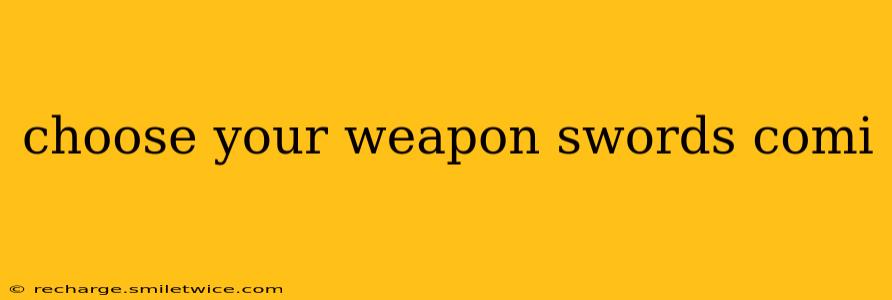Choosing Your Weapon: A Deep Dive into Swords in Comic Books
Comic books have a rich history of showcasing iconic weaponry, and swords frequently take center stage. From the gleaming blades of Arthurian legends to futuristic energy sabers, the sword in comics represents power, honor, and often, a deeply personal connection to the wielder. But choosing the "right" sword depends entirely on the context – the character's personality, their fighting style, and the narrative itself. This exploration will delve into the diverse world of comic book swords, exploring different types, their symbolic significance, and the factors that make them legendary.
What are the different types of swords depicted in comic books?
Comic books aren't limited by the constraints of historical accuracy. We see a vast array of swords, ranging from the realistic to the fantastical.
-
Classical Swords: These are often based on real-world historical counterparts, like katanas (as seen with Wolverine), rapiers (Zorro), or broadswords (many fantasy comics). These choices often reflect the character's origin or intended aesthetic.
-
Fantasy Swords: These swords often possess magical properties, unique designs, or are imbued with ancient power. Think of Excalibur, Stormbreaker, or the swords wielded by countless fantasy heroes. These are usually tied to mythology or lore within the comic’s universe.
-
Sci-Fi Swords: Futuristic comics introduce energy swords, plasma blades, and other technologically advanced weaponry. These often represent a blend of cutting-edge technology and traditional sword fighting styles. Examples could include lightsabers (a clear influence across various comics) or unique energy blades crafted within a specific fictional universe.
-
Unique & Symbolic Swords: Many comic book swords transcend simple categorization. They might be forged from unique materials, have intricate designs tied to the character's history, or even possess sentient qualities. These swords become extensions of the wielder, representing their journey and inner struggles.
What makes a comic book sword iconic?
The iconicity of a comic book sword isn't solely about its appearance. Several factors contribute:
-
The Wielder: The character wielding the sword is often as important, if not more so, than the sword itself. A legendary warrior wielding a simple sword can make that blade iconic through their actions and legacy.
-
Narrative Significance: The sword's role in pivotal moments of the story – crucial battles, symbolic oaths, or character-defining moments – greatly enhances its status.
-
Visual Design: A striking and memorable design can make a sword instantly recognizable, often setting it apart from more generic counterparts.
-
Mythos & Lore: A rich history and compelling backstory, woven into the fabric of the comic's universe, add layers of depth and intrigue to a sword, making it more than just a weapon.
How do different sword types reflect the character wielding them?
The choice of sword often reflects the character's personality and fighting style:
-
A nimble, precise swordsman might prefer a rapier or katana, emphasizing speed and agility.
-
A powerful warrior might wield a greatsword or claymore, focusing on brute strength and overwhelming force.
-
A mystical or magical character might use a sword imbued with magical properties, enhancing their abilities and reflecting their connection to the supernatural.
Where can I find more information about swords in comics?
Exploring various comic book websites, wikis dedicated to specific universes (like Marvel or DC), and even academic articles discussing comic book symbolism can unveil a wealth of information on the specific swords and their significance within their respective narratives. This deeper exploration can truly appreciate the artistic and narrative choices behind these powerful symbols.
In conclusion, the world of swords in comic books is vast and varied, reflecting not just the artistic vision of creators but also the multifaceted nature of the characters who wield them. The sword transcends its function as a mere weapon; it becomes a symbol, a legacy, and a crucial part of the narrative tapestry.
